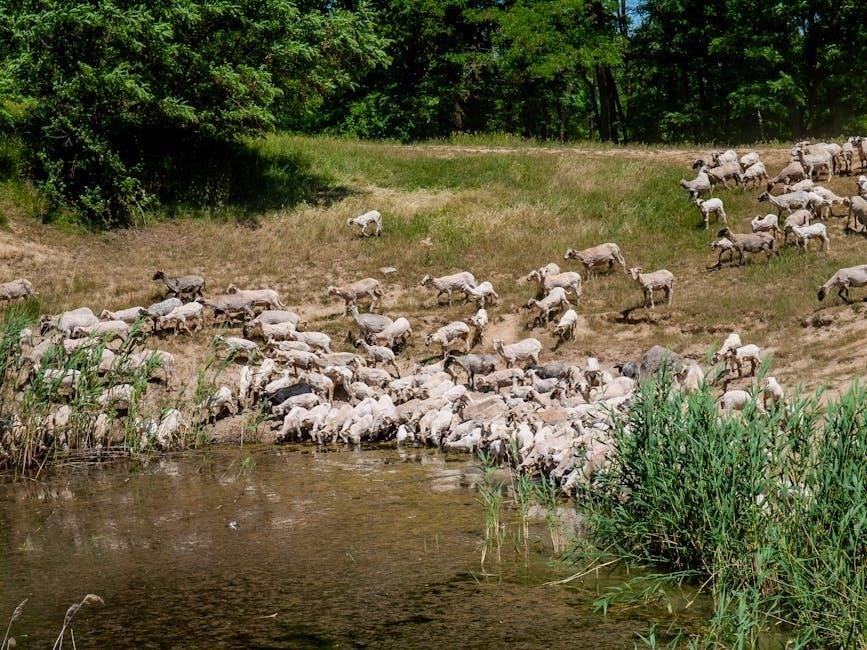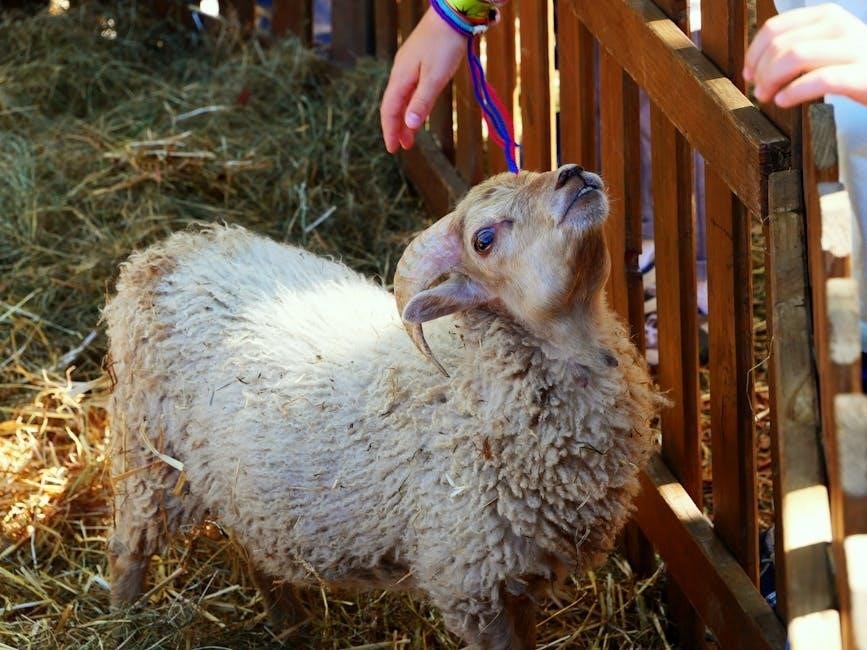
Wool, a gripping sci-fi novel by Hugh Howey, explores a dystopian world where humanity survives in underground silos. Originally self-published in 2011, it gained immense popularity, leading to a successful series and an upcoming Apple TV adaptation.
1.1 Summary of the Novel
Wool, written by Hugh Howey, is set in a post-apocalyptic world where humanity resides in a massive underground silo. The story follows Juliette Nichols, a determined mechanic, as she uncovers the dark secrets of her world. The silo, a self-sustaining community, is governed by strict rules and lies to maintain order. Juliette’s journey reveals the truth about the silo’s purpose, the toxic outside world, and the oppressive system controlling its inhabitants. The novel explores themes of isolation, freedom, and survival, delving into humanity’s ethical dilemmas and the consequences of deception. Through Juliette’s struggle, Wool examines the resilience of the human spirit in a world torn apart by catastrophe and control.
1.2 Background and Publication History
Wool, Hugh Howey’s debut novel, was initially self-published in 2011 as an eBook, marking a significant milestone in indie publishing success. The book gained rapid popularity through online platforms, leading to a print deal with Simon & Schuster in 2012. This shift highlighted the impact of digital publishing in reaching audiences. The novel’s success also spurred the creation of a graphic novel adaptation, further expanding its reach. Howey’s unique storytelling and the dystopian theme resonated globally, establishing him as a prominent voice in sci-fi. The book’s journey from indie roots to mainstream acclaim underscores the evolving landscape of literature in the digital age, proving that compelling stories can thrive beyond traditional publishing routes.

Major Themes in “Wool”
Wool explores themes of isolation, freedom vs. control, and survival, delving into humanity’s ethical dilemmas and the consequences of a rigidly controlled society.
2.1 The Theme of Isolation
In Wool, isolation is a pervasive theme, as humanity is confined to a vast underground silo, severed from the outside world. The silo’s rigid structure and strict rules enforce physical and emotional detachment, creating a society where individuals struggle with feelings of confinement and disconnection. Juliette Nichols’ journey highlights the psychological impact of isolation, as she grapples with the loss of her husband and the claustrophobic environment. The silo’s walls, both literal and metaphorical, symbolize the barriers that prevent true human connection, emphasizing how isolation can lead to fear, mistrust, and a fragmented community. This theme underscores the human need for freedom and the consequences of enforced seclusion.
2.2 Freedom vs. Control
In Wool, the struggle between freedom and control is central, as the silo’s rigid hierarchy enforces strict rules to maintain order. The silo’s inhabitants are denied access to the outside world, conditioned to fear it, and forced to conform to the system. Juliette Nichols’ defiance of authority highlights the tension between individual freedom and oppressive control. The silo’s leaders manipulate information and suppress dissent, creating a culture of obedience. Yet, the desire for truth and autonomy drives characters like Juliette to challenge the status quo, risking their lives for the chance to break free. This conflict underscores the human need for freedom and the dangers of unchecked control, raising questions about the cost of survival in a dystopian society.

Key Characters
Juliette Nichols is the determined and courageous protagonist who uncovers the silo’s secrets. Her journey challenges the system and inspires others. Supporting characters like Lukas and Mayor Jahns play pivotal roles in shaping the story’s dynamics and revelations.
3.1 Juliette Nichols
Juliette Nichols is the protagonist of Wool, portrayed as a determined and resourceful individual. Her role as a mechanic in the silo initially keeps her grounded in the system. However, her life takes a dramatic turn when her husband, Solo, is sent to clean the outside, an act that leads to his death. Juliette’s grief and curiosity drive her to uncover the truth about the silo and the outside world. Her journey reveals a complex character, blending resilience, intelligence, and a deep desire for freedom. Juliette’s transformation from an obedient citizen to a rebellious leader is central to the story, making her one of the most compelling characters in the novel. Her actions challenge the status quo and inspire others to question their reality; Through her, Hugh Howey explores themes of humanity, survival, and the quest for truth in a controlled environment.
3.2 Supporting Characters
The supporting characters in Wool are intricately woven into the narrative, each contributing to the story’s depth and complexity. Jahns, the mayor of the silo, embodies authority and the burden of leadership, while Marnes, Juliette’s husband, serves as a catalyst for her journey. Lukas, the head of IT, represents the oppressive systems in place, highlighting the silo’s rigid control. Together, these characters reveal the psychological and societal layers of life underground. Their interactions with Juliette and the silo’s hierarchy underscore themes of isolation, control, and the human desire for truth. Each character’s role, though secondary, is pivotal in shaping the world of Wool and the protagonist’s quest for understanding.

The Setting of the Story
Wool is set in a massive underground silo, a self-sustaining community with 144 floors. The outside world is toxic and barely visible, emphasizing the silo’s isolation and control.

4.1 The Silo
The silo in Wool is a vast underground structure designed to preserve humanity after a global catastrophe. With 144 floors, it houses a tightly controlled society governed by strict rules and regulations. Life within the silo is structured to maintain order and survival, with each floor serving a specific purpose, from agriculture to mechanical systems. The inhabitants live in a world of enforced ignorance, where knowledge of the outside is restricted, and any dissent is harshly punished. The silo’s rigid hierarchy and isolation create a claustrophobic atmosphere, emphasizing themes of confinement and control. This setting is central to the novel’s exploration of human resilience and the consequences of isolation.
4.2 The Outside World
The outside world in Wool is a toxic, post-apocalyptic environment rendered uninhabitable by an unspecified cataclysm. The silo’s inhabitants believe the surface is deadly, with limited glimpses provided by grainy, controlled video feeds. The ruling class maintains this narrative to uphold control, discouraging curiosity or dissent. Juliette Nichols’ investigation reveals the silos’ true purpose: to preserve humanity until the planet heals. The outside world remains shrouded in mystery, symbolizing both danger and freedom. This duality underscores themes of isolation and deception, as the silo’s residents struggle with the truth about their existence and the world beyond their confined reality. The novel’s portrayal of the outside world serves as a backdrop for exploring humanity’s survival instincts and ethical dilemmas in a fractured society.

Adaptations and Media
The Apple TV series adaptation, starring Rebecca Ferguson and Tim Robbins, brings Hugh Howey’s dystopian vision to life, exploring humanity’s survival in a toxic world.
5.1 Apple TV Series Adaptation
The Apple TV series adaptation of Hugh Howey’s “Wool” brings the dystopian novel to life, featuring a stellar cast, including Rebecca Ferguson and Tim Robbins. Set in a toxic future, the series explores the survival of humanity within underground silos. The production promises to capture the claustrophobic atmosphere and moral dilemmas central to the book. Fans of the novel eagerly anticipate the visual interpretation of the silo’s oppressive regime and the unfolding mysteries. With its gripping narrative and talented cast, the series is expected to resonate with both existing fans and new audiences. The adaptation underscores the enduring appeal of Howey’s vision of a fractured world.
5.2 Casting and Production
The Apple TV adaptation of Hugh Howey’s “Wool” boasts an impressive cast, with Rebecca Ferguson and Tim Robbins in lead roles. Ferguson portrays Juliette Nichols, the determined leader, while Robbins plays Bernard, a complex figure tied to the silo’s secrets. The production team, known for their attention to detail, has crafted a visually stunning representation of the silo’s claustrophobic environment. Director Morten Tyldum brings a cinematic depth to the story, emphasizing the moral dilemmas and societal tensions. The series has been filmed in numerous locations, blending practical sets with cutting-edge visual effects to depict the silo’s intricate design. This high-budget production aims to faithfully adapt Howey’s vision, ensuring fans and newcomers alike are immersed in the gripping dystopian narrative.

Sample Chapters and Content
Wool’s first chapters introduce the silo’s oppressive world, focusing on Juliette’s journey. These initial segments set the tone, highlighting humanity’s struggle in a dystopian underground society.
6.1 Overview of Sample Chapters
The sample chapters of Wool by Hugh Howey introduce readers to a gripping dystopian world. The story begins with the silo, a self-sustaining underground community, where life is governed by strict rules. The first chapters focus on Juliette Nichols, a determined mechanic whose curiosity about the silo’s secrets drives the narrative. Through her investigation, the oppressive nature of the silo’s society is revealed, along with hints of a catastrophic event that forced humanity underground. These chapters set the tone for the series, blending mystery, suspense, and ethical dilemmas. They also highlight Juliette’s growing awareness of the silo’s true purpose, which challenges her understanding of the world and her place within it. The sample chapters effectively draw readers into the story, making them eager to explore further.
6.2 Spoiler Summary

In Wool, Juliette Nichols uncovers the silo’s dark secrets, revealing its purpose to preserve humanity after a global catastrophe. The outside world is toxic, and the silo’s leaders manipulate information to maintain control. Juliette’s investigation exposes the truth about the silo’s intent and the lies surrounding the outside world. Her discoveries spark rebellion, challenging the silo’s authoritarian regime. The novel’s climax reveals the silo as part of a larger network, raising questions about humanity’s survival and the ethics of control. Juliette’s journey transforms her from an obedient citizen to a leader determined to challenge the system, setting the stage for further exploration of the silo’s mysteries and humanity’s fate.

Study Guide and Resources
A comprehensive Wool study guide offers insights into Hugh Howey’s work, including character analysis, themes, and quiz questions. It also features a detailed biography of the author.
7.1 Author Biography
Hugh Howey is a renowned American author, best known for his sci-fi novel Wool. Born on August 23, 1975, in Monroe, North Carolina, Howey developed a passion for writing at an early age. Before gaining fame, he worked various jobs, including as a yacht captain and a bookseller. Howey’s self-publishing journey began with Wool, which he initially released in serialized form online. The novel’s success led to traditional publishing deals and international acclaim. His work often explores themes of survival, freedom, and societal control. Howey’s innovative approach to self-publishing has made him a pioneer in the digital literary landscape, inspiring countless aspiring writers. His contributions to dystopian fiction have solidified his place as a significant voice in the genre.
7.2 Quiz Questions
Test your understanding of Wool with these essential questions:
- What is the primary setting of the novel, and how does it influence the characters’ lives?
- Who is Juliette Nichols, and what role does she play in uncovering the silo’s secrets?
- How does the theme of isolation impact the inhabitants of the silo?
- What motivates characters to risk their lives by attempting to go outside?
- How does the silo’s governance maintain control over its population?
These questions help readers delve deeper into the story’s themes, characters, and plot. They are ideal for book clubs, classrooms, or personal reflection to enhance comprehension and discussion.

Writing Style and Approach
Hugh Howey’s gripping narrative in Wool blends suspense and moral dilemmas, creating a claustrophobic atmosphere that immerses readers in the silo’s oppressive world. His accessible prose explores human resilience and societal control, captivating audiences with its emotional depth and thought-provoking themes.
8.1 Hugh Howey’s Writing Style
Hugh Howey’s writing in Wool is characterized by a gritty, immersive style that captures the claustrophobic atmosphere of the silo. His prose is concise yet evocative, building tension through gradual revelations about the world and its history. Howey excels at creating moral ambiguity, forcing readers to grapple with complex ethical dilemmas alongside the characters. His ability to balance action with introspection adds depth to the narrative, while his focus on human emotions and survival instincts makes the story relatable. The slow-burn pacing and layered storytelling keep readers engaged, exploring themes of isolation, freedom, and the resilience of humanity in the face of catastrophic collapse.
8.2 The Graphic Novel Version
The graphic novel adaptation of Wool brings Hugh Howey’s dystopian vision to life with striking visuals. Illustrated by Jimmy Broxholm and others, it captures the oppressive silo environment and the haunting beauty of the outside world. The artwork enhances the story’s tension, particularly in scenes depicting the silo’s restrictive society and the mysterious toxic landscape. The graphic novel remains faithful to the original narrative while offering a fresh perspective through its visual storytelling. It appeals to fans of the novel and introduces the story to new readers, emphasizing themes of isolation and control. This adaptation enriches the Wool universe, providing a compelling visual exploration of its grim yet thought-provoking world.
Wool by Hugh Howey has left a lasting impact on dystopian literature, sparking discussions on survival, ethics, and humanity. Its success paved the way for adaptations and future sequels.
9.1 The Impact of “Wool”
Wool by Hugh Howey has had a profound impact on dystopian literature, resonating with readers worldwide. Its exploration of isolation, freedom, and ethical dilemmas has sparked meaningful discussions. The novel’s success highlights the power of self-publishing, as Howey initially released it independently before gaining mainstream recognition. The story’s gripping narrative and well-crafted characters have inspired a dedicated fan base, leading to the creation of a series and a graphic novel adaptation. Additionally, the upcoming Apple TV series further amplifies its influence, introducing the story to new audiences. Wool has not only redefined the sci-fi genre but also left a lasting mark on modern storytelling.
9.2 Future of the Series
The future of the Wool series is promising, with ongoing developments in both literary and media realms. Hugh Howey’s work has sparked a dedicated fan base, leading to discussions about potential sequels and spin-offs. The success of the Apple TV adaptation, starring Rebecca Ferguson and Tim Robbins, is expected to further expand the series’ reach. Fans anticipate more explorations of the silo world and its mysteries, possibly delving into unseen corners of the narrative. Additionally, the graphic novel version continues to captivate audiences, offering a visual interpretation of the story. With its enduring popularity, Wool is likely to remain a significant influence in dystopian literature and media for years to come.